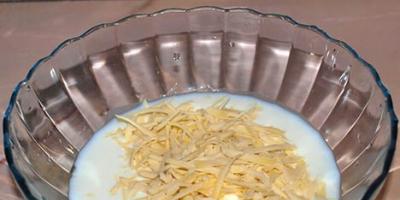This article brings together many different step by step instructions, which will help you make an excellent crucible for melting aluminum. It will only take a couple of days and some money.
DENIAL OF RESPONSIBILITY
When melting aluminum at home, you will encounter fire and molten metal. Do not neglect safety equipment and protective clothing. Responsibility for any injuries caused lies solely with you! I have nothing to do with this.
Step 1: Materials and Tools





Show 4 more images




Looking back, I can say that although the list is large, all these materials are not difficult to obtain. The most expensive was the burner. I tried to save money, but honestly, this is a very useful purchase.
Other materials for the smelter:
- Fast setting cement mortar. I took a 9 kg bucket for 500 rubles.
- The container in which we will mix the solution
- A device that will be used to stir the solution
- Large coffee can (15 cm)
- Small coffee can (10 cm)
- Hacksaw for metal
- Drill (or other tool for making holes in metal)
- 0.4kg gas cylinder (make sure it is empty)
- A steel rod, for example from a printer, about 30 centimeters long (you can buy a 20 cm steel rod from your local hardware store)
- Marker (or any other marking tool)
- Adhesive tape
- Cardboard
- Short (5-7 cm) iron or steel pipe, into which the end of the burner enters. (Not necessary)
- Round hammer (any other one will do)
- A little propane (I buy it in a tourist store, 250 rubles for two 450 g cylinders)
- Oven (optional)
- Vice (optional, but very useful)
- Small baking dish (optional, you just need something to pour the aluminum into).
- Some cheap wire (no more than 3mm, but strong enough to support a little weight)
Step 2: Making the crucible





Show 10 more images










So I took the empty one gas cylinder and clamped him in a vice. I used a hacksaw to cut it along the weld and cut off the edges. If you look at the bottom you will see 4 holes. Use a marker to mark the lines level with them.
Use a hammer to hammer away at the metal where the line is. This will create a nose. (this can be difficult, but once the spout is ready, pouring will become much easier).
Now draw lines up the sides of the holes near the spout. Offset 6mm from the top, mark a line and drill on both sides. I used a drill, but you could use any other drilling tool. Make sure the holes match the size of the metal rod.
Wear a pair of leather work gloves. Now mark the center of the rod. Heat it over a burner. When the metal turns red, bend it in half to make sharp corner. (see picture)
Dip the metal in water and heat the ends one at a time. Bend them so they face each other. Dip the ends in water and reheat the center bend. Bend it over and unfold it so that the ends you bent fit into the holes in the propane tank.
Cool the center bend and make sure your new handle moves freely in the holes.
Now you have a great crucible.
Step 3: Making a Horn





Show 10 more images










Working with an aluminum melting furnace is quite complex, so we will do it in several stages.
- Cut a hole in the side of a large jar about 1 inch from the base.
- Make sure the pipe fits there (you can measure using a piece of paper or cardboard)
- Using a knife, cut a hole in the bottom of a small coffee can in the shape of a mouse hole (make sure the pipe fits there).
- Wrap a small jar in cardboard (this is done to make it easier to get out) and cut the same hole in the cardboard in the shape of a mouse hole.
- Dilute the concrete solution. I used 11 cups of cement and about 2.5 cups of water.
- Pour the solution tightly into the bottom of a large jar until it is level with the hole.
- Place the pipe in the hole and place the small jar in the larger one, connecting them with the pipe through the mouse holes. Try to center the small jar.
- It is advisable to position the pipe diagonally. This will help create a spiral of flame. (see picture)
- Fill the walls with concrete and compact tightly.
- I let the solution sit for a while, then put the jar in the oven and set it to 200 degrees.
- After 30 minutes, pull it out and take out a small jar wrapped in cardboard.
- Return the vessel to the oven for 2 hours. This will help remove moisture.
- Use oven mitts and remove the jar from the oven. Bring it to your workplace.
- Prepare the burner and insert it into the pipe.
I recommend using eye protection. The first firing is necessary to remove moisture. You can see steam coming out of the cement. Let it burn for about half an hour, then leave to dry overnight. Finally we placed a crucible in there to burn off the old paint.
Step 4: Melt the aluminum







Show 11 more images











Casting aluminum at home is very dangerous, so keep water handy and wear thick leather or welding gloves, safety glasses, and make sure the area is well ventilated.
Preheat the oven and place the crucible there. I waited until the bottom of the crucible turned red.
Start with small pieces of aluminum. (I had old doorbell tubes). You can use jars, but they tend to contain a lot of waste. I would wait until some aluminum has accumulated before I start melting the aluminum cans.
You'll probably have a hard time at first, so take your time. Once you have enough aluminum, it will be able to maintain its melting temperature and you will be able to melt large pieces in a matter of seconds. I found it in the garage old frame from a scooter that has already served its purpose. Now this frame will turn into something new.
I found that you can cover the crucible with the top of a gas bottle. This allows for better heat retention and faster melting of the metal.
I had a problem piece of scooter that I couldn't get the steel screw out of, so I dunked it in a pool of molten metal and it never came back. The hammer helped deal with difficult pieces of metal and sediment in the crucible.
Once the crucible is full or you run out of aluminum, you need to scrape off the slag. The slag will float on top and will look a little different than the metal underneath.
To remove slag, an unnecessary piece of metal is useful. We used the same scrap metal and made a hook out of it to lift the crucible and another piece that fits into the holes in the bottom of the crucible to make it easier to empty. You can use a small screwdriver for this.
Make sure you have something to pour the aluminum into. I'm going to save it for the future, so I form the aluminum into small briquettes - they are small and melt easily in a crucible. You could just use a depression in the wet sand or something like that. It is most convenient to use muffin tins, however, they can no longer be used for their intended purpose.
Pour the metal into the molds. It is very hot, so remember to wear hand and eye protection!
Because I'm impatient, I don't wait for the aluminum to cool, but throw it in cold water. In this case, the water may boil violently. It's spectacular, but very dangerous. Be careful!
Step 5: What's next?

We have a lot of bars now. You can save up for a small lathe, for about 10 thousand rubles, and make various interesting parts from aluminum!
In a home workshop, a compact crucible furnace helps cast small elements of mechanisms, blanks, souvenirs, and interior accessories from aluminum. The unit is designed so that it is possible to melt the material in a short time with minimal effort. Devices used on an industrial scale, on the contrary, are aimed at saving fuel; they are controlled automatically.
The classification is usually based on the type of energy used to melt the metal. Thus, gas crucible furnaces, like electric ones, are widely used in the industrial sector; they are actively used for working with aluminum and other low-melting materials.
Models operating on solid fuel are common in relatively small workshops that do not have a narrow specialization (in particular, among home craftsmen, since this is the simplest configuration). Induction crucible furnaces that use an electromagnetic field are placed in a separate category; they are connected to an alternating current source.
Induction crucible furnace
Reasons for the demand for induction units:
- high performance;
- ease of management and maintenance, ample opportunities to automate the process;
- the possibility of draining the mass without residue, completely emptying the crucible;
- ensuring rapid melting;
- absence of intermediate heating elements.
Depending on the operating conditions, furnaces are distinguished:
- compressor (create excess pressure),
- vacuum,
- open.
Induction crucible furnaces can be:
- periodic,
- continuous,
- semi-continuous.
The melting crucible is:
- ceramic ( best option, does not come into contact with the processed materials);
- conductive graphite (durable, suitable for working with precious scrap);
- metal.
The latter is divided into water-cooled and conductive modifications.
The induction melting furnace consists of a frame, an inductor, a heating chamber, a tilting mechanism, vacuum system. The unit does not have a core; a cylindrical melting crucible is placed directly in the cavity of the inductor. The mixture of starting materials is melted in a crucible under the influence of electromagnetic energy. All components are enclosed in a casing - this frame provides structural rigidity and prevents power dissipation.

Simpler are the diagrams of crucible furnaces operating on the basis solid fuel, for example, on charcoal - they are easier to do with your own hands from scrap materials. The metal cylinder body is reinforced with a fireproof layer of concrete or fireclay clay with sand. Fuel is subsequently placed into this shaft. Place a crucible on top, for example, a teapot, a tin can with thick walls, or any strong stainless steel container.
In the lower sector of the shaft there is a hole intended for air supply, and a lattice base is also located here. These elements allow you to maintain the combustion process and change the temperature. Excess air is removed through the damper. For injection, a vacuum cleaner pipe or a hair dryer is usually used.
Crucible furnaces, designed for simultaneous melting of more than 10 kg of aluminum, are equipped with a lid so that the metal is heated evenly. All elements of primitive models are made of cast iron or steel - these materials do not deform when heated in artisanal conditions.
Differences between homemade and factory units
To understand the difference, you need to take the purpose of using the equipment as a starting point. Home-assembled units are usually needed for periodic use (breaks can be significant), so the minimum cost, the ability to perform simple manipulations, and low maintenance requirements come to the fore.
If the results of smelting are used to earn money, it is more advisable to purchase a factory induction model - such equipment promotes accurate work, helps to accurately observe measurements, and reduces to zero the likelihood of unwanted impurities. The same equipment is difficult to do with your own hands - assembling an inductor, choosing a crucible , screen arrangement requires specialized skills. Not everyone can create a capacitor bank and generator.

The ergonomic characteristics of stoves should not be overlooked. In artisanal preparations, they are given a minimum of resources; as a rule, such variations are inconvenient to use and are often dangerous due to the use of improvised materials. In factory lines to ensure comfortable work proven technologies are used, in particular regarding configuration and rotary mechanism crucible. It is important that they create conditions to prevent injuries.
Do-it-yourself crucible furnace: step-by-step instructions
If you need to periodically melt up to 3 kg of scrap, the performance of a unit made of furnace bricks will be sufficient.
Materials and technology
You need to prepare:
- 20-25 red bricks;
- grill grate;
- electrical tape;
- hair dryer and a piece of pipe suitable for the diameter of its nozzle;
- a tin can with high thick walls;
- steel wire;
- coal (needed for ignition).
Bricks are laid at the base of the body; they serve as fireproof protection for the unit. The crucible in this case is a tin can; 2 holes are made on opposite sides of its upper part and steel wire is passed through them. This improvised handle will help you pull the container with the alloy out of the furnace.
To supply air, home craftsmen use a hairdryer turned on in the “cold” mode, attach a piece of pipe to it using electrical tape, and the structure turns into an improvised air duct.
The design of such a crucible furnace for melting aluminum is extremely simple; it can be completed without specific skills. Cannot be used during production Consumables zinc coated: toxic fumes may be released during use.
The first row is laid out in the form of a rectangular outline; the internal hole must have such parameters that a whole brick fits into it. The next row is done in a similar way, but on one side two bricks should form a corridor into which oxygen will flow, with dimensions corresponding to the air duct described above.

A grill grate is installed on top; if it is not there, you can use a metal plate or a lid with holes. The grate is secured by the third row of bricks; here there is no need to leave an opening for the air duct.
The preparation of a hair dryer and a pipe is brought to the corresponding brick row, and the air duct is turned on only after the coal poured onto the grate has been melted. The intensity of combustion can be changed by switching the hair dryer mode lever. The crucible is hung on the outermost masonry by a wire; if necessary, it can be additionally secured with 2 bricks. When the jar warms up and turns slightly red, you can load aluminum scrap into it.
Such a stove is simple to set up and working with it will not cause any difficulties. After the metal has melted, the crucible is carefully removed, holding it by the wire. To avoid burns, it is recommended to use fire-resistant gloves. You need to make sure in advance that all components used do not contain toxic substances. During operation, you also need to ensure that splashes of water do not enter the container.
Aluminum alloys have low melting point and good workability details. And there is always a lot of aluminum scrap on the farm.
That's why aluminum is often melted at home to replace non-standard or small parts of mechanisms: a blank is cast, and then processed lathe. Sometimes souvenirs and small interior items are made from aluminum with their own hands.
Melting furnace structure
Homemade furnaces for melting aluminum consist of a body - metal cylinder (2), lined with refractory (clamotte with sand or concrete). Inside the mine is charcoal (8), serving as fuel. It is installed crucible (3)- a container in which the metal will melt. The crucible can be a thick tin can, a teapot or any container made from of stainless steel.

At the bottom of the shaft (6) made air injection hole (7) through lattice base (4), which allows you to maintain combustion and regulate the temperature in the furnace.
A hair dryer or a vacuum cleaner pipe is used as a blower. Damper (5) necessary to remove excess air.
For ovens with a capacity of several tens of kilograms, you need cover (1) for quick and uniform heating of the metal. In small ovens you can do without it.
Furnace elements should not deform or melt when heated. Therefore use aluminum cases, tubes and crucibles are unacceptable. It is best to take steel or cast iron details.
Reference. Also used as fuel for smelting aluminum natural gas or electricity.
How to make a furnace for melting metal?
Creating a small unit that can melt several kilograms of aluminum scrap is not a difficult task. To lay out the oven on garden plot will be required following materials :

- red bricks - 20-25 pcs.;
- high tin can - 1 pc.;
- grill grate - 1 pc.;
- drying hair dryer - 1 pc.;
- piece of pipe, with a diameter suitable for the outlet of the hair dryer - 1 PC.;
- roll of electrical tape;
- line segment steel wire length 30-50 cm;
- coal for ignition (the quantity depends on how much aluminum needs to be melted).
The bricks will appear simultaneously and body and fireproof coating oven, a tin can will act as a crucible. At the top of the can are being done two holes opposite each other, and through them the wire is threaded. It will be possible to lift and remove the crucible with the melt from the furnace. The air will be supplied from the hairdryer turned on in cold air mode. Tape or tape to the outlet of the hair dryer attach a piece of pipe- this will be the air duct.
Such simple circuit The furnace is convenient because no tools are actually required to create it; everything is done by hand.
Important! Do not use oven elements with zinc coating, because when aluminum is melted, toxic zinc fumes will be released.
Brick well installation plan
- Gives his all one row bricks in the form of a rectangular well. The internal dimensions of the hole should be approximately length and width of one brick. On one side two bricks laid out so as to form a corridor for the air duct. The width of the corridor is tube diameter for air supply.
- On the laid out row grating is installed. Instead of a grill grate, you can use any metal lid or plate with holes for air supply.
- Placed on the grill second row bricks, without any gap for the air duct.

Photo 1. Finished brick well for the melting furnace. The edges are reinforced with metal strips, the air duct opening is visible.
- Created air duct. Tape or tape to the hairdryer a piece of pipe is wound. To ensure structural strength, the connection point turns around thick paper , and then connects duct tape. Electrical tape is a more elastic material compared to adhesive tape, so it is more convenient to work with. The cold air supply button is also secured with tape on the hairdryer. Ready the mechanism is brought to the bottom row bricks.
- In the stove well on the grate coal is poured and melted for ignition. The hair dryer turns on, which activates the combustion process.
Advice. The air supply intensity can be adjusted by changing hair dryer operating mode, and distance between pipe and window for the air duct.
- Tin is installed to the top row bricks for the wire threaded into it. Like a pot over a fire, it hangs over the grate.
- After lighting the furnace and installing the crucible third row are placed two more bricks so that from a rectangular hole you get a square one. This will fix the can inside the housing and heat up the oven space faster.
After heating the jar into it scrap can be loaded for remelting. A sign that the jar is warming up is its redness.
The principle of the design and operation of such a furnace is very simple and does not cause difficulties. However, it is always worth remembering safety precautions:
- work in fire-resistant gloves;
- avoid water getting into the melt;
- do not use materials containing toxic substances.
You might also be interested in:
Two-can design

Another variety homemade stove for melting aluminum is a design made of two large cans. One of them serves body, in which a hole is cut for air supply, and bottom of the second jars with holes serves as a divider.
A crucible is installed inside the jars.
Such a device very compact, and small volumes of metal can be melted even in a ventilated garage. However, the design is not resistant or fire resistant, and will only last a few cycles.
Possible problems and their solutions
Carelessly assembled device causes the oven to operate inefficiently and makes it dangerous to use. Here are a few points to pay attention to:
- Slots and gaps in a brick building. They can be caused by chips on bricks or loose fit of refractories to each other. Gaps reduce fuel efficiency and reduce combustion intensity and temperature. Aluminum in a crucible may simply not melt.
Therefore, after laying out each row, a visual check is carried out for the presence of holes. Holes covered with a sand-clay mixture or covered with fire-resistant material.

Concrete mortar It is recommended to use only in the case of a stationary unit that is not planned to be disassembled. But Asbestos sheets and chips should not be used in places where the stove is heated, because this material is a carcinogen.
- Violation of the horizontal level the buildings. Misalignment reduces the stability of the structure and creates conditions for uneven distribution of coal. The result is uneven heating of the crucible and the metal in it.
Laying out each, especially the bottom row of bricks controlled by level. You can also check horizontality placing a jar of water on the grill. On flat surface The top edge of the water will be parallel to the edge of the jar.
Aluminum is a versatile metal and can be used to make many interesting things, including DIY parts. In addition, it has a relatively low melting point, which allows casting at home.
Of course, to melt aluminum you will need to make a small furnace; it can even be made from coffee cans, as demonstrated by the author. It only took him $23 to create the homemade product, not including the cost necessary tools. You can see how this oven is made and make one similar to yours, following the example.
Materials and tools for homemade work:
- two tin cans, one larger, the other smaller (it is highly not recommended to use zinc-coated cans);
- a household hair dryer (will blow air);
- piece metal pipe(adapter for hair dryer to supply air to the oven);
- scotch;
- metal scissors (ordinary ones will do, if you don’t mind);
- pliers with long handles (for gripping the crucible);
- gloves;
- coal as fuel, lighter fluid and more.




Mini-stove manufacturing process:
Step one. Making the stove body
The stove body is actually taken ready-made; it is a large tin can of soup, canned food, etc. You need to choose jars with thicker metal. In the lower part, the author made a hole, to which a hair dryer is then connected using a pipe. The hole must be made according to the diameter of the pipe. The easiest way is to make it square, but it’s better to tinker a little and make it round hole by pipe diameter.

Step two. Supercharging installation
An ordinary household hair dryer is used as an air blower. It must be equipped with an air supply system and have at least two operating speeds. A piece of metal pipe is attached to the hairdryer using tape, and its other end is inserted into the hole previously cut in the bottom of the can. The author secures the cold air supply button with tape; it must be on all the time. Before starting the stove, you need to turn on the hair dryer and make sure that there is no air leakage at the junction of the pipe with the hair dryer. If there is, you still need to wrap it with tape.


You can find a piece as a pipe water pipe, a pipe from a vacuum cleaner will also work, and so on. If the stove is large, you need to take a longer pipe, as it can get very hot and the heat will reach the hairdryer. However, cold air from a hairdryer should cool it well.
Step three. Furnace crucible
The author also has a ready-made crucible for the stove, it is a small tin can from coffee or the same canned food. It is important to remember that such a crucible can only be used once; according to the author, it will inevitably burn out when used again. And this will entail that liquid aluminum will leak into the furnace, which is not very pleasant.

Step four. Furnace tests and conclusions
That's it, the oven is now ready to start. You need to install a crucible in the center and place coal in a circle. Then, after pouring lighter fluid over the coal, you need to wait until it burns completely. After this, you need to turn on the hairdryer at low speed. Tests must be carried out on outdoors, otherwise a spark may fly out of the oven and a fire may occur. In addition, when you first start there will be a lot of smoke from the tin can.


Aluminum beverage cans are suitable sources of aluminum. But, according to the author, due to the fact that the metal in them is very thin, they do not melt, but burn; in the end, too little aluminum is obtained for casting; in general, such a starting material is not very suitable.
If you decide to melt the cans, you must first crush them.
From 12 cans you can get approximately 150 g of aluminum.
2 cans will give about 300 g, and from 36 cans you can get 450 g of aluminum.
After starting the furnace, the crucible should turn red, this indicates that the furnace is ready and aluminum can be placed in the crucible. When the aluminum is completely melted, it can be poured into molds to form ingots; this is very convenient for further work with the metal.
The author recommends warming up the furnace before placing aluminum there because tin can An oxide film is formed, which protects the metal from overheating. If aluminum is placed before the oven heats up, it can burn through the metal and leak out. You should always work with thick gloves that do not burn or melt, since the oven heats up to very high temperatures.
Casting molds should under no circumstances be wet, otherwise during casting the liquid hot metal may explode and fly in different directions.
The author does not insert the hairdryer pipe completely into the oven, since even at low speeds there is too much air supply. By adjusting the distance between the pipe and the oven window, you can achieve the required air supply, and as a result, the temperature.
Important!
When constructing such furnaces, zinc-coated cans cannot be used. The thing is that zinc, when heated, releases toxic fumes that will be harmful to health. If cans with a different coating cannot be found, then you need to work in respiratory protection and do not heat the oven to high temperatures.
Among other things, this furnace can be used as a small forge. When heating steel, a crucible is not installed in it. As a result, it is quite possible to heat a file and then make a small knife or other product from it. For example, you can make small souvenir swords from nails.








